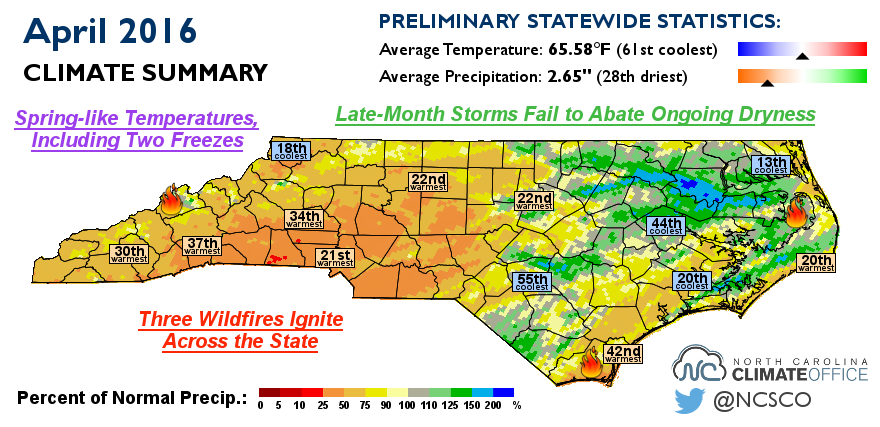One ongoing dry pattern, two chilly mornings, and three wildfires were all parts of our April conditions in North Carolina.

Spring-like Temperatures, Including Two Freezes
Following the 10th-warmest March on record, the abnormal heat backed off in April. The statewide mean temperature of 65.58°F ranks as the 61st-coolest — or 62nd-warmest — April since 1895.
Our high, low, and average temperatures all ranked near normal, and with the exception of two mornings dipping below freezing, there were few extreme temperatures last month. We have yet to hit the 90 degree mark this year, although that’s not unusual; our typical first occurrence of 90°F temperatures is in mid to late May.
Those two freezing mornings on April 6 and 10 did come slightly later than the normal last freeze date for eastern North Carolina. Lows in the upper 20s took their toll on crops, especially since temperatures hadn’t dipped below freezing since early March. Crop reports from USDA suggest that corn, wheat, and fruits including peaches, apples, and blueberries all suffered damage due to the two freeze events.
Late-Month Storms Fail to Abate Ongoing Dryness
The lamb-like weather from March continued through much of April, with quiet conditions and little precipitation, especially early in the month. April finished as the 28th-driest in the past 122 years with an average statewide precipitation of 2.65 inches — almost an inch below the recent 30-year average.
Showers and storms in the final week of the month brought some needed rainfall, but monthly precipitation totals were still quite low in many areas. Tryon in the southern Mountains received just 1.40 inches of rain all month, ranking as the 6th-driest April in the past 98 years. Lincolnton was the driest spot in the state last month, reporting just 1.14 inches of rain.
The spring so far has been particularly dry in western North Carolina. Many sites including Charlotte, Asheville, and Boone are more than four inches below their normal March and April precipitation. The ongoing dryness led the US Drought Monitor to expand Abnormally Dry conditions across 84% of the state by the end of the month.
Although the Abnormally Dry conditions expanded in area during April, conditions haven’t substantially worsened in severity. That’s largely thanks to the late-month rains that replenished topsoil moisture and the lack of excessively warm weather to dry out the fields.

Three Wildfires Ignite Across the State
April’s dry conditions provided an ideal environment for wildfires to ignite. Some of the commonly used fire danger indicators — including the Energy Release Component, which models the potential energy available to a fire in the form of dry fuels like timber and forest litter — peaked in the Very High to Extreme range. We had not seen widespread values that high in almost two years.
Those potent environmental conditions, including several days with low humidity and high winds, allowed three large wildfires to begin and spread during April:
- The Whipping Creek fire started on April 18 with a spark from roadside maintenance near Highway 264 along the Dare and Hyde County line. Crews worked through the end of the month before containing the fire on April 30. The fire burned 15,453 acres.
- The Clemmons Road fire near Bolivia in Brunswick County began on April 19 when a debris burn escaped containment. The fire burned 1,578 acres before it was contained by the NC Forest Service.
- The Silver Mine fire in Madison County near the Tennessee border was one of several in the Appalachians during the past month. It began on April 21, and as of May 1, it was 90% contained after consuming 5,300 acres.

Although it has been a few years since the last active fire season in North Carolina, this spring is providing a reminder of the danger fires pose and how quickly a small fire can grow out of control under the right conditions.
“We are lucky that no one has been injured and no homes have been lost,” said Shane Hardee, the Incident Commander for the Clemmons Road Fire. “People need to remember that you should always be cautious when burning and never burn on dry and windy days.”